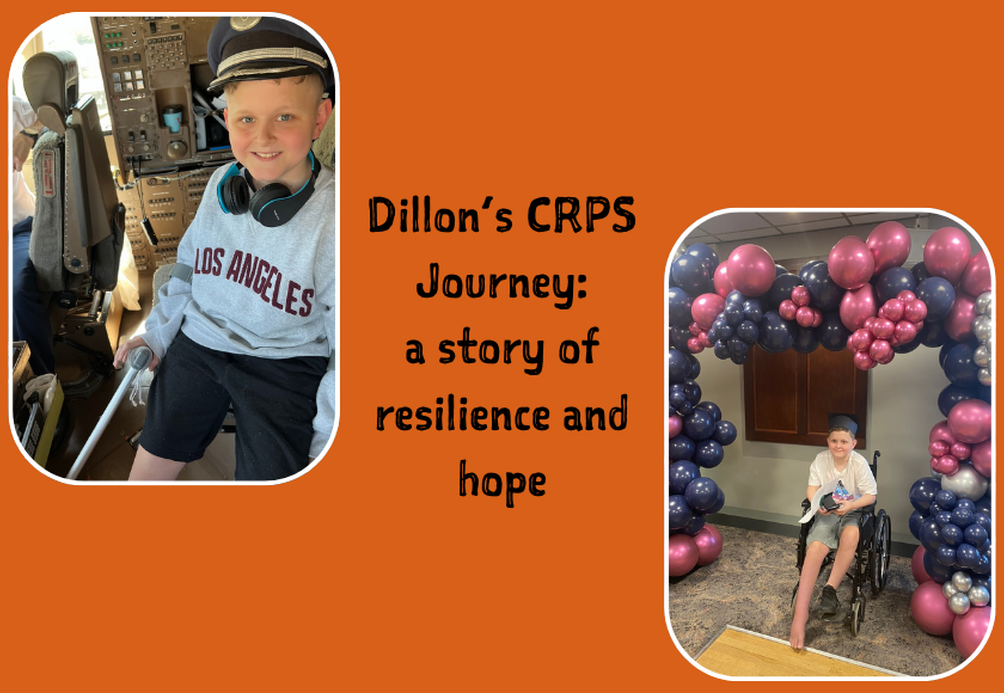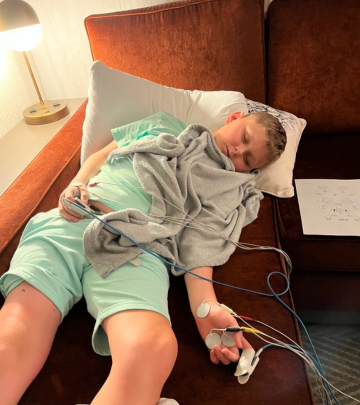We use cookies to improve your experience. By accepting you agree to our cookie policy
Let's meet Dillon Wilford, a young boy from Sharples. Dillon's CRPS story is an uplifting one and he is keen to share his tumultous journey with other unfortunate children on the same path.

The day before everything changed was a typical one for 10-year-old Dillon Wilford from Bolton. It was November 2022; Dillon was tired from a busy week at school when he felt some pain and noticed a slight limp in his left leg one evening. He recalled feeling a strain during PE lessons earlier but didn’t make much of it.
There was nothing to suggest that Dillon’s world was about to be turned upside down.
He woke up in tremendous pain the next morning, barely able to walk. His mum Melanie and sister Maddie thought that perhaps Dillon was being his usual dramatic self.
Maddie says, “Dillon has always been so dramatic…in an amazing way. So, I think, at first, when he had that limp, it was kind of like ‘Oh come on, get to school, get ready…stop being silly’…and it was the next day that he just couldn’t put any weight on it at all.”
The family soon realised that Dillon was not bluffing. They rushed him to their local A&E and he started undergoing a series of tests to figure out what was going on. All major test results came back negative. This should have been a huge relief for everyone but, in reality, provided little consolation as Dillon was only getting worse.
Maddie said “At first, they thought it was a sprain and when it didn’t heal like a sprain would and it was just getting worse and the excruciating pain and sensitive touch started, my mum took him back to A&E. He had X-rays… [but] they couldn’t say anything, then they said it was in his head because they couldn’t see anything wrong, they just didn’t understand” says a frustrated Maddie.
After three long, exhaustive months, Dillon finally received his devastating diagnosis. By chance, he was seen by a different consultant than the one planned. He took one look at Dillon’s dry skin and discolouration and knew it was Complex Regional Pain Syndrome (CRPS). The family quickly learned that CRPS pain is chronic and severe, usually much greater than an injury would typically cause. In Dillon’s case, there was no prior trauma or major injury before initial symptoms. Thinking back, Maddie recalls Dillon may have tripped at school, but it was so minor it was almost dismissible.
As the days went on, the Wilford family tried to grasp their new reality but really struggled to make any sense of it. Their adventurous little boy who loved sports and dreamt of being an astronaut one day was now a mere shell of his former self. No one knew what to do and the future was looking rather bleak.

Due to the immense pain CRPS was causing Dillon, he was forced to leave school and trade his regular activities with life in confinement at home. He found himself bed-bound and needing considerable assistance in his daily tasks. His mental health was deteriorating quickly, and he missed simple things like playing with his friends and going out with his family.
Dillon also had heightened sensitivity to the slightest touch; so much so that he begged his mum to have his leg amputated (a highly controversial topic in the CRPS community, which you can read more about here).
Melanie said, “One day he was eating a strawberry, one tiny seed fell off and hit his leg and he screamed. If he got a cat hair on his leg, he screamed. It was hell, absolute hell. Like a life sentence for a child.”
Dillon’s harrowing screams filled the Wilford home. On his worst days, he thought about harming himself and he no longer wanted to live.
Dillon was referred to a local children’s hospital to manage his CRPS. According to Maddie, “They’re still not just set up for it. The Rheumatology doctor was kind of just like…‘Do what I say, stand on it, walk on it, you’ll be fine within a week’. Now looking back…that’s just so ridiculous and unfathomable.”
Maddie adds, “Over the last 2, nearly 3 years, it feels like we are experts…but back then, even when we were Googling it, the NHS website doesn’t tell you the half of it. It’s all kind of ifs and maybes and no one really knows.”
Dillon took Paracetamol, Ibuprofen and Lidocaine patches to manage his pain. He was also given morphine during his hospital stays but it made him delusional and only offered temporary relief. He was then prescribed a cocktail of pain relief including Gabapentin, Amitriptyline and Melatonin but there was minimal improvement.
Doctors also suspected that Dillon may be autistic. His family refused an assessment at that time as Dillon was already overstimulated and in constant, immense pain.
Dillon continued to have appointments but there were few and far between, with physiotherapy being only once every two months. He visited a Pain Management clinic in Bath and although it allowed him to practice calming techniques, the pain remained the same.
The Wilford family decided it was time to take matters into their own hands and ramped up their research efforts to find a suitable treatment. Unfortunately, connecting with others living with CRPS, they realised that there were only a few options in the UK with limited effectiveness.
The NHS currently provides CRPS patients with education and management, physical rehabilitation, pain relief and psychological support.
Dillon’s family started to think about expensive specialised treatment abroad. Melanie set up a GoFundMe account and they started looking at ways to raise money.
While exploring their options, the family came across a 16-week treatment plan at The Spero Clinic in Arkansas, USA. The treatment would cost them a staggering £100k and, although it could not cure his CRPS, it was known to help people get into remission.
Dillon would be offered light therapy and oxygen treatment and there was the prospect of being able to walk again. They felt encouraged and started making travel plans. Melanie and Maddie organised several fundraisers including a golf tournament and a family disco to raise money for Dillon’s treatment.
During this time, they were approached by a member of the public through their GoFundMe page. The lady had a grandson with CRPS and he was able to successfully go into remission with the help of a pioneering new treatment in Texas, USA. On day 5 of treatment, he was nearly pain-free and able to have some of his old life back.
Dillon’s family was doubtful initially and wondered about the credibility of the promised treatment. However, after speaking to experts in the US, they learnt about the VECTTOR machine that offers a form of electrical stimulation to nerves in the body. This leads to the creation of vital neuropeptides which in turn improves circulation throughout the body and reduces pain.
This sounded too good to be true, but Dillon’s family decided to give it a shot. At this point, there was nothing to lose.
The VECTTOR treatment was a fraction of the cost compared to the one they were initially considering. Dillon started treatment last summer, more than a year after receiving his diagnosis. It took some time to see results as his CRPS had progressed significantly, but Dillon soon began to take his first steps again.
He became pain-free for the first time in months. The treatment brought his pain level down to an incredible zero the majority of the time, compared to his usual average of eight or nine out of 10.
Melanie couldn’t believe how things had started to turn around; it had been a long time coming. The family was overwhelmed with relief; the boy who had lost everything to CRPS was starting to get his life back.
There were little wins from being able to wear socks again, to shoes, and most importantly to smile again.
The family was able to bring the machine back to the UK to help manage Dillon’s CRPS. The treatment, which initially takes about 80 minutes and is given twice a day, can be reduced to once a day as patients start to get better. Dillon would need to continue with his physio alongside VECTTOR treatment but, overall his progress was truly remarkable.

Earlier this year Dillon turned 12 and started Year 7 in a secondary school. This was a huge step for him, previously having to drop out for more than a year, after receiving his diagnosis. Dillon was delighted to continue learning and be with his friends once again.
Today, he uses the VECTTOR machine as required along with physio and is learning to take things at his own pace. His school has been fantastic in supporting him and Dillon is able to join for half days for most of the week. There are a few missed days here and there due to flare-ups (and learning how to manage them) but, overall, he is once again thriving.
The family was also able to resume their annual tradition of celebrating Dillon’s birthday at Alton Towers. Dillon has to be reminded to pace himself and to take breaks before the pain kicks in; he was glad his family insisted on bringing his wheelchair along so he could rest. It was a brilliant day out for everyone.
No one is happier than Dillon, of course, who dares to dream once again. He still wants to be an astronaut one day and is excited to turn his dreams into reality.
“He’s doing really well. He still struggles in some ways that I think most 12-year-olds wouldn’t, but I think he’s been through so much. We’ve also gotten back in touch recently with the Psychology team at our local children’s hospital to help with his mental health, but he is so much better now” says Maddie.
The family is grateful to see Dillon’s recovery and consider themselves extremely fortunate for they know not everyone gets to tell a similar story. As Dillon’s advocates, Melanie and Maddie feel no child should have to go through the nightmare that their little boy did. Melanie said, “As a parent, you go through this horrendous and traumatic event that kind of takes your child’s life away from them and you will do anything to put that right.”
Currently, they are trying to get the NHS to offer the VECTTOR machines locally so other families can benefit from the treatment that gave Dillon his life back.

